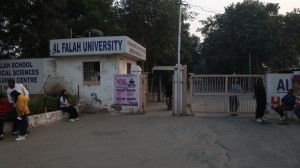The story of the past is often found in the bits and pieces of imprints it leaves behind in modern cities. Hidden behind the multistory buildings, the busy markets and, of course, the rising pollution levels in Delhi, lie several epochs of history, visible till date through the architectural delights they have left behind. One such little moment in Delhi’s history, that went on to be remembered as the very beginnings of a nationalistic movement in the country, is the revolt of 1857.
On Sunday morning, a group of passionate history enthusiasts were out to revisit the sites in Delhi that tell the story of the revolt of 1857. The heritage walk organised by a group called Delhi Heritage Walks, and led by Kanika Singh (historian and professor at Ashoka University) aimed at recreating the historical period surrounding 1857 in Delhi. Starting from the Nicholson cemetery near the Kashmiri Gate metro station, the walk traced a number of spots in the busy north Delhi region that weaved the story of 19th century Delhi and the events and characters surrounding the great uprising.

As explained by Singh, while Meerut was the starting point of the rebellion that went on to spread elsewhere, Delhi had a very significant role to play in the whole incident. The soldiers who broke out in rebellion against the British officers in Meerut rushed to Delhi to meet with the shrinking forces of Mughal emperor Bahadur Shah Zafar. It is in Delhi that the rebels had to fight against the strength of the East India Company forces. In the spirit of rebellion, they went about destroying everything associated with company rule. Delhi was very important to the British. “The British could not afford to lose Delhi, if they lost Delhi they would lose the empire,” said Singh.
 In case of Delhi in 1857, it is actually the sites commemorating the story of the British that is preserved and was traced in the walk.
In case of Delhi in 1857, it is actually the sites commemorating the story of the British that is preserved and was traced in the walk.
But then history is always written by the victors. Same is the case with monuments, memorials and most other such historical residues, which tell us the story from the point of view of the victors. In case of Delhi in 1857, it is actually the sites commemorating the story of the British that is preserved and was traced in the walk. Nonetheless, it does give us an idea of the life and times lived by Indians in the 19th century.
Nicholson cemetery
This active burial ground is named after one of the most formidable characters of the revolt of 1857 and hailed as a hero by the British – John Nicholson. Located right outside gate number 4 of the Kashmiri gate metro station, this cemetery holds a number of graves of characters associated with the revolt. Nicholson’s grave is in the midst of thick vegetation.
Nicholson is supposed to have stormed into the old city of Shahjahanabad through Kashmiri Gate with his troops and taken on the Indian rebels successfully. In the process, however, he lost his life. Legend has it that he held on to his last breath till the time he heard of the confirmed news of the British emerging victorious.
 Nicholson is supposed to have stormed into the old city of Shahjahanabad through Kashmiri Gate with his troops and taken on the Indian rebels successfully.
Nicholson is supposed to have stormed into the old city of Shahjahanabad through Kashmiri Gate with his troops and taken on the Indian rebels successfully.
As described by William Dalrymple in his works, Nicholson was a very daunting personality, but notorious as a racist as well. Further, as Singh explained during the walk, the marble slab used to cover Nicholson’s grave had been looted by the British from a Mughal garden.
Grave of Yasudas Ramachandra
Story continues below this ad
This ornate grave located along the footpath on the right hand side of the cemetery is that of an Indian, Yasudas Ramachandra. Preceding the revolt, he was a professor of Mathematics in the Delhi College (currently the Zakir Hussain college). In the early 19th century, Delhi college was the centre of the Delhi renaissance and Master Ramachandra was strongly associated with it. However, while he was actively involved in translating works of western knowledge into Urdu, he had also converted to Christianity and hence was at the receiving end of the wrath of the rebels who were out to destroy everything and everyone associated with the British. Shocked by the attack on him, he escaped Delhi and came back only when the British took over the city.
 This ornate grave located along the footpath of the right hand side of the cemetery is that of an Indian, Yasudas Ramachandra.
This ornate grave located along the footpath of the right hand side of the cemetery is that of an Indian, Yasudas Ramachandra.
However, little did he realise that even though the British had taken over Delhi, he would once again be targeted, this time by the foreign rulers because of the colour of his skin.
Kashmiri Gate
This historical landmark that gives the neighbourhood its name is located right around the Nicholson cemetery. This is one of the most important sites associated with the revolt since it was from this point that the British entered the city of Shahjahanabad.
 Kashmiri Gate is one of the most important sites associated with the revolt since it was from this point that the British entered the city of Shahjahanabad. (Wikimedia Commons)
Kashmiri Gate is one of the most important sites associated with the revolt since it was from this point that the British entered the city of Shahjahanabad. (Wikimedia Commons)
Story continues below this ad
Kashmiri gate was one among the 14 gates protecting the city of Shahjahanabad and the British had to bomb it in order to enter the city. In fact, the bruises of the British attack are still visible in the architectural remains of the site. From Kashmiri Gate the British troops took about a week to reach the Red Fort. It gives us an idea of the bitterness of the fight that took place.
Kashmiri gate market
Located right next to the Kashmiri gate is this busy shopping area which has been in existence for ages. It was built as part of the city of Shahjahanabad in the 17th century and was a posh area even then. Large number of Mughal princes had their properties in the area including Shah Jahan’s eldest son Dara Shikoh.
 Kashmiri gate market was built as part of the city of Shahjahanabad in the 17th century and was a posh area even then.
Kashmiri gate market was built as part of the city of Shahjahanabad in the 17th century and was a posh area even then.
Once the Europeans started coming in, this locality was a favourite among them as a spot for building their estates. After the revolt of 1857, the British overhauled the topography of Delhi to avoid another such revolt. The Europeans then evacuated the Kashmiri Gate market and moved to the civil lines. But this locality remained a large shopping area. Even today, on pulling down the hoardings of the shops here, one can see an evident late 19th, early 20th century pattern of European architecture.
Old campuses of St. Stephens and Hindu
Right around Kashmiri Gate market and across the St James Church is located the old campus of St Stephen’s College, close to the old Hindu campus. Anybody familiar with college politics in Delhi University would be aware of the intense rivalry between St Stephens and Hindu. Few people know, however, that this rivalry can be traced back to the late 19th century, following the revolt.
Story continues below this ad
After the revolt, the British government withdrew all support for the Delhi college. Instead, St Stephen’s was built as an institution aimed at producing Indians who would be trained to help British governance – bureaucrats and civil servants. The college initially started at a small haveli in Chandni Chowk and then moved to the spot across St. James Church before moving further into the current location inside the Delhi university north campus.
Contemporary to the educational changes being brought about in the St. Stephen’s College was also an emerging parallel nationalistic streak in education that was against the western dominated education system. The Hindu College was representative of this emerging nationalism and hence was at loggerheads with the St Stephens college, the legacy of this confrontation continuing till date.
The Telegraph memorial and the British magazine
The walk ended with a visit to the Telegraph memorial and the British magazine, both lying outside the St James Church. Both these sites are memorials commemorating the British officers who lost their lives fighting in the revolt.
 The Telegraph memorial (Wikimedia Commons)
The Telegraph memorial (Wikimedia Commons)
The Telegraph memorial was built in honour of the Telegraph officials who stayed put and kept warning officials in Ambala to disarm their soldiers so that the rebellion does not spread further and were successful in effectively getting their message across. The act was very significant for the survival of the British empire, and an inscription at the memorial reads – “the electric telegraph saved India.”
Story continues below this ad
The magazine on the other hand was the British ammunition depot. The rebels needed ammunition for the sake of the revolt and targeted it. The British commanders stationed there realised that they could not hold it up any more and blew it up. It was regarded as an act of sacrifice by them and a memorial was built to commemorate their act of bravery against the Indian rebels.
 The British magazine memorial
The British magazine memorial
Years later, the Indian government added an inscription to the monument commemorating the act of the rebels that says:
“Persons described as rebels and mutineers in the above inscription were members of the army in service of the East India Company trying to overthrow the foreign government.”
The second part of the walk visiting sites associated with the 1857 revolt would be continued by Delhi Heritage Walks on the following Sunday, November 20.

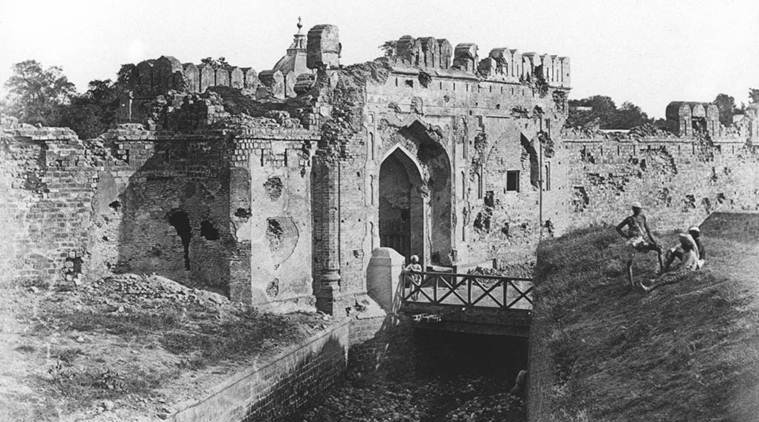 Starting from the Nicholson cemetery near the Kashmiri Gate metro station, the walk traced a number of spots in the busy north Delhi region that weaves the story of 19th century Delhi. (Wikimedia Commons)
Starting from the Nicholson cemetery near the Kashmiri Gate metro station, the walk traced a number of spots in the busy north Delhi region that weaves the story of 19th century Delhi. (Wikimedia Commons)
 In case of Delhi in 1857, it is actually the sites commemorating the story of the British that is preserved and was traced in the walk.
In case of Delhi in 1857, it is actually the sites commemorating the story of the British that is preserved and was traced in the walk.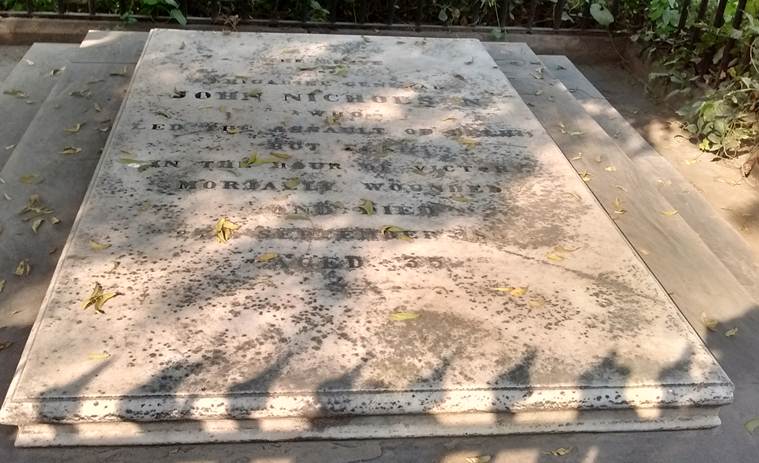 Nicholson is supposed to have stormed into the old city of Shahjahanabad through Kashmiri Gate with his troops and taken on the Indian rebels successfully.
Nicholson is supposed to have stormed into the old city of Shahjahanabad through Kashmiri Gate with his troops and taken on the Indian rebels successfully. This ornate grave located along the footpath of the right hand side of the cemetery is that of an Indian, Yasudas Ramachandra.
This ornate grave located along the footpath of the right hand side of the cemetery is that of an Indian, Yasudas Ramachandra.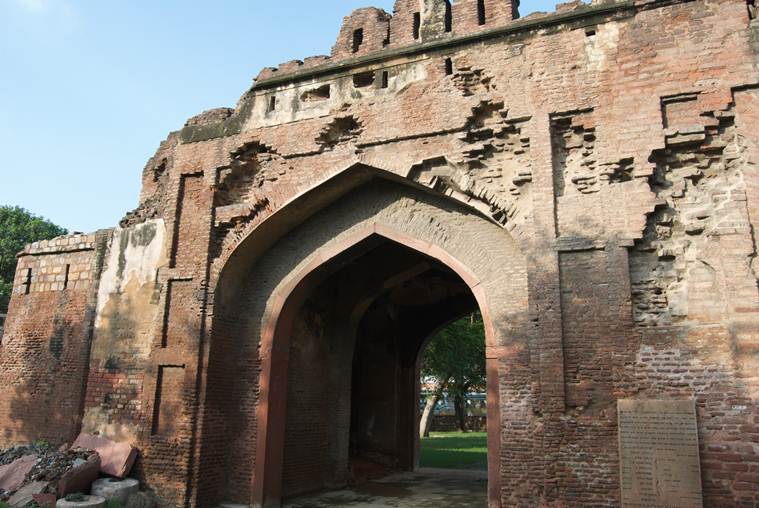 Kashmiri Gate is one of the most important sites associated with the revolt since it was from this point that the British entered the city of Shahjahanabad. (Wikimedia Commons)
Kashmiri Gate is one of the most important sites associated with the revolt since it was from this point that the British entered the city of Shahjahanabad. (Wikimedia Commons) Kashmiri gate market was built as part of the city of Shahjahanabad in the 17th century and was a posh area even then.
Kashmiri gate market was built as part of the city of Shahjahanabad in the 17th century and was a posh area even then.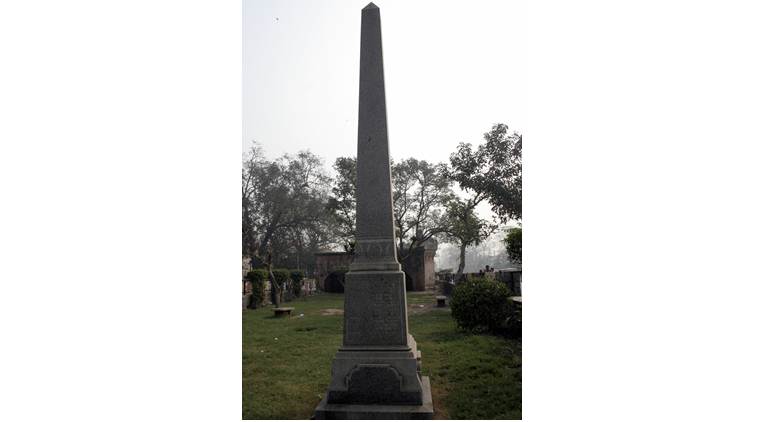 The Telegraph memorial (Wikimedia Commons)
The Telegraph memorial (Wikimedia Commons) The British magazine memorial
The British magazine memorial






